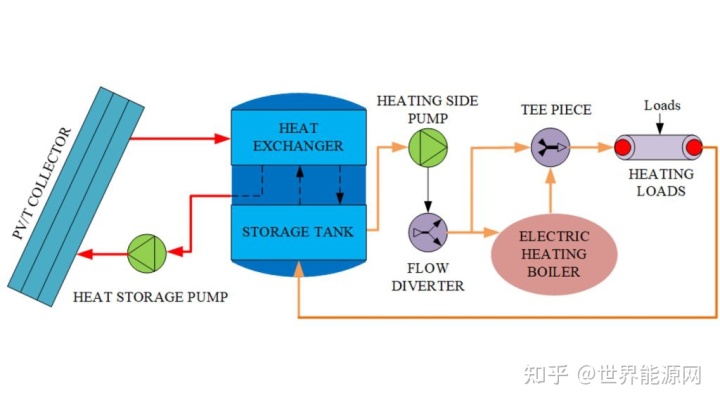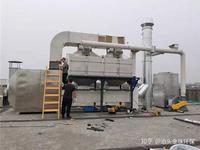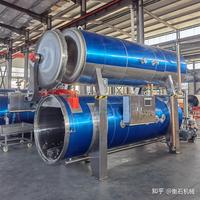
在太阳能装置中加入有机物动力源,可以在一年中最冷的几个月为单层住宅提供100%的供暖,且有助于环保。在温暖的月份,该系统可以产生盈
在太阳能装置中加入有机物动力源,可以在一年中最冷的几个月为单层住宅提供100%的供暖,且有助于环保。在温暖的月份,该系统可以产生盈余的电力,可以回售给电网。

在AIP出版社出版的《可再生和可持续能源杂志》上,中国和美国的研究人员概述了一个计算机模拟模型,通过增加生物质能作为另一种可再生能源来解决太阳能固有的间歇性的挑战,以推进可靠的、可负担的供热解决方案,同时减少二氧化碳排放。
"我们展示了这种混合系统如何在单户家庭中提供比化石燃料更清洁、更节能的加热解决方案,"共同作者Gaoyang Hou说。"该系统在农村社区会很方便,那里的农场有大量的农业废弃物形式的生物质,可以与太阳能发电相结合,以缩小城乡电力差距,并在这个过程中帮助环境。"
拟议的太阳能-生物质能混合系统是基于分布式多发电技术,整合了光伏-热能(PV/T)和生物质能源。
生物质是由可再生的有机物产生的,如玉米皮、坚果壳、木浆以及食物和动物的废弃物。由光伏板和热能收集器组成的光伏/热能系统是一种新兴的技术,可以将太阳能转化为热能和电能,具有较高的能源转换效率。
对新兴的分散式混合系统的研究主要集中在社区和商业温室农场。研究人员根据中国西北地区一栋单层平房从11月到3月的供暖需求对他们的系统进行了评估,该地冬天的温度可能会降到零下20摄氏度(零下4华氏度)以下。
在总的能量输入中,光伏/T集热器产生了52%的电能,并获得了8%的可用热能。生物量产生了房屋供暖所需的其余40%的电力。
"共同作者Lei Xu说:"在整个采暖季,太阳能在能源供应方面占主导地位,而生物质能源在需要时启动,以弥补能源的不足。
他们在TRNSYS(瞬态系统仿真工具的简称)中创建了仿真模型,这是一个模块化的热系统软件,用于评估热能和电能可再生能源系统的性能。
他们的混合系统模拟包括光伏/T集热器、热泵、带有浸入式盘管换热器的储罐、分流器和备用电锅炉等部件。
研究人员正在开发一个太阳能-生物质能系统模型,以满足一个小型商业建筑的供暖和制冷需求,如果成功的话,计划开发一个原型进行实验测试。
原文:
Solar-Biomass Hybrid System Satisfies Home Heating Requirements in Winter
Adding an organic matter power source to a solar energy unit could provide 100% heating for a single-story home during the coldest months of the year and help the environment. In the warmer months, the system could generate electricity surpluses that can be sold back to the grid.

In Journal of Renewable and Sustainable Energy, published by AIP Publishing, researchers in China and the United States outline a computer simulation model addressing the challenge of solar power’s inherent intermittency by adding biomass as another renewable energy source to advance a reliable, affordable heating solution while reducing carbon dioxide emissions.
“We demonstrate how this hybrid system provides a cleaner, more energy-efficient heating solution than fossil fuel in single-family homes,” co-author Gaoyang Hou said. “The system would be convenient in rural communities, where farms have large amounts of biomass in the form of agricultural waste that can be combined with solar power to close the urban-rural electricity gap and help the environment in the process.”
The proposed solar-biomass hybrid system is based on distributed multi-generation technology that integrates photovoltaic-thermal (PV/T) and biomass power sources.
Biomass is produced from renewable organic matter, like corn husks, nut shells, wood pulp, and food and animal waste. A PV/T system, composed of PV panels and thermal collectors, is an emerging technology that converts solar energy into both heat and electricity with higher energy conversion efficiency.
Studies on emerging decentralized hybrid systems have focused on neighborhoods and commercial greenhouse farms. The researchers evaluated their system based on the heating needs of a single-story cottage from November to March in northwest China, where temperatures in winter can dip below minus 20 degrees Celsius (minus 4 degrees Fahrenheit).
Of the total energy input, the PV/T collector generated 52% of the electrical energy and captured 8% of the available thermal energy. The biomass generated the remaining 40% of the electricity needed to heat the house.
“For the entire heating season, solar power predominates the energy supply side, with the biomass energy generation kicking in when needed to make up the energy deficit,” co-author Lei Xu said.
They created their simulation model in TRNSYS (short for transient system simulation tool), a modular thermal system software used to assess the performance of thermal and electrical renewable energy systems.
Their hybrid system simulation consisted of a PV/T collector, heat pump, storage tank with an immersed coiled-tube heat exchanger, flow diverters, and backup electric boiler, among other components.
The researchers are developing a solar-biomass system model to meet heating and cooling demands of a small commercial building and, if successful, plan to develop a prototype for experimental testing.
问:2023年锅炉价格/多少钱?
上一篇:供热锅炉脱硝厂家
下一篇:分布式供暖站助力地区清洁供暖








